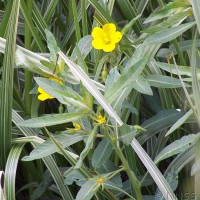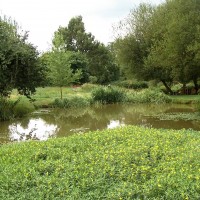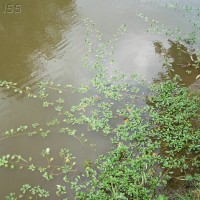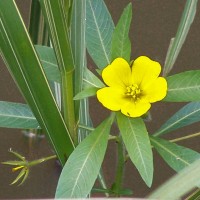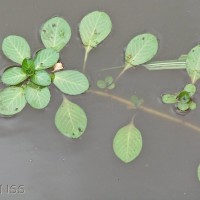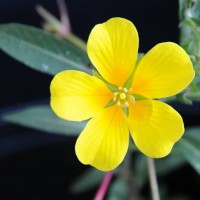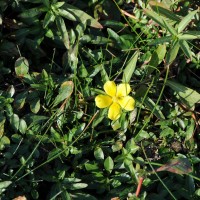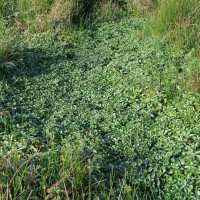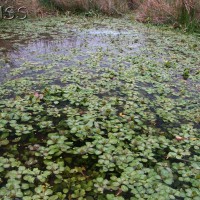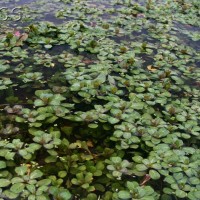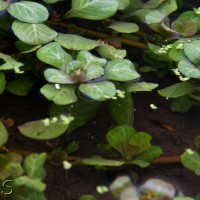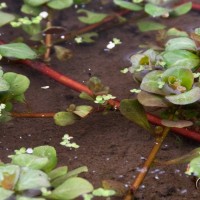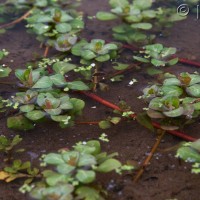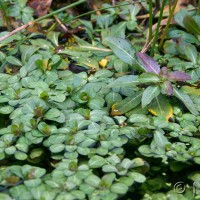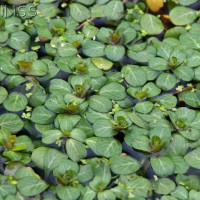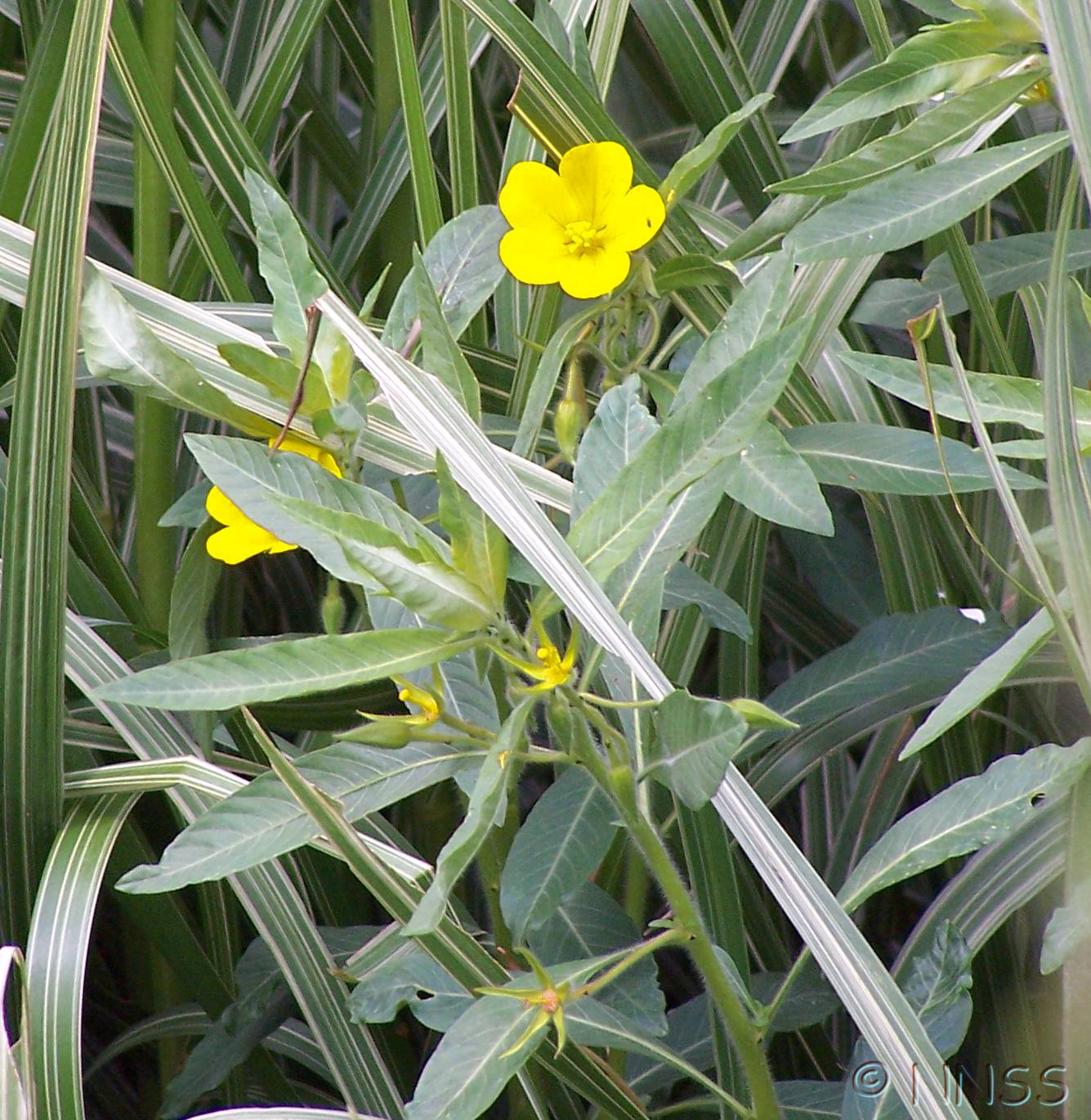
Uruguay Water-primrose - Ludwigia grandiflora
Expand and collapse the sections below by clicking on the title or + / - icons.
Short description of Ludwigia grandiflora, Uruguay Water-primrose
A creeping perennial water plant with long oval leaves like a willow and a large, bright yellow flower like that of a primrose. It can be distinguished from L. peploides by differences in chromosome number and morphology, most notably the dull, cuneate leaves, pointed stipules, larger sepals (> 10 mm), and presence of pneumatophores (Armitage et al., 2013).
Impact summary: Ludwigia grandiflora, Uruguay Water-primrose
At many British sites L. grandiflora has spread rapidly to become locally dominant, covering ponds and shading out other species including nationally rare species such as brown galingale Cyperus fuscus.
Habitat summary: Ludwigia grandiflora, Uruguay Water-primrose
Ponds, farm reservoirs and slow-flowing rivers and ditches. Most populations are in ornamental ponds where it is likely to have been planted (e.g. ornamental ponds in large gardens, on golf courses, etc.).
Overview table
| Environment | Freshwater |
|---|---|
| Species status | Non-Native |
| Native range | Bolivia, Colombia, Costa Rica, Ecuador, Guatemala, Peru, Paraguay, Uruguay, Argentina, Chile, Southern Brazil |
| Functional type | Land plant |
| Status in England | Non-Native |
| Status in Scotland | Non-Native |
| Status in Wales | Non-Native |
| Location of first record | v.c.11 (Barton Golf Course) |
| Date of first record | 1999 |
Origin
North and South America.
First Record
L. grandiflora was first recorded in the wild in Britain in 1998 in a shallow lagoon at the Wildflowl and Wetlands Trust reserve at Barn Elms (Middlesex) and in 1999 in ponds on a golf course at Barton-on-Sea, Hampshire, where it was still abundant in 2016. It has been grown at the Royal Horticultural Society's garden at Wisley in Surrey since 1994.
Pathway and Method
L. grandiflora is planted for ornament in garden ponds, fishing lakes, farm reservoirs and ornamental ponds on golf courses. It possibly has also originated as an escape from ornamental collections or via secondary dispersal via vegetative fragments in water or on machinery.
Species Status
L. grandiflora is an invasive species in northern Europe (especially in France) where it has spread rapidly to form dense, impenetrable mats in water-bodies, shading out native species and altering water chemistry. It has the potential to become invasive Britain in the future. Since it was first discovered in 1998 it has been recorded from approximately 25 sites, including a SSSI in Hampshire where it now dominates the vegetation of a species-rich pond, despite attempts to remove it, out-competing nationally rare species such as Cyperus fuscus.
Dispersal Mechanisms
In its native range L. grandiflora disperses by seed and vegetatively, but in Britain it appears to be spread manily via clonal growth and detached vegetative fragments. At present dispersal appears to be restricted to within single water-bodies although it has spread very locally between ponds, presumably due to movement of fragments by water, livestock or machinery. The seeds can survive for up to three months in water indicating a high potential for long distance dispersal within connected water-bodies.
Reproduction
L. grandiflora is self-incompatible and so the main mode of reproduction in Europe appears to be clonal spread and the dispersal of detached fragments following initial introduction.
Known Predators/Herbivores
Although a number of natural enemies of L. grandiflora have been identified in its native range (herbivores, pests or pathogens) none have been reported from Britain.
Resistant Stages
The seeds are resistant to low temperatures and submersion, surviving in water for up to 3 months.
Habitat Occupied in GB
Ponds, farm reservoirs, ditches and marshes.
Since it was first discovered in 1998 L. grandiflora has been reported from approximately 25 sites, mainly in southern and central England (Somerset, Dorset, Wiltshire, Hampshire, Wight, Surrey, Sussex, Middlesex, Oxford, Bucks, Gloucs, Worcs) with outlying sites in South Lincolnshire, West Lancashire and Northeast Yorkshire.
Environmental Impact
In Europe L. grandiflora can form impenetrable stands on bare mud or in water that outcompete native plant species for light, nutrients and pollinators. It also suppresses associated species via allelopathic activity that can lead to reduced oxygen levels with knock-on effects for multiple trophic levels including aquatic invertebrates. Eradication methods (e.g. spraying with glyphosate) have the potential to impact threatened species and habitats on sensitive sites.
Health and Social Impact
None known.
Economic Impact
In other parts of the world L. grandiflora infestations have caused interference with flood control and drainage systems, clogged waterways and interfered with navigation and recreational acitivities. The costs of eradication and control have also proved costly in some countries although not in GB due to early detection and control by the Environment Agency.
Identification
Armitage, J.D., Konyves, K., Bailey, J.P., David, J.C. & Culham, A. 2013. A molecular, morphological and cytological investigation of the identity of non-native Ludwigia (Onagagraceae) populations in Britain. New Journal of Botany 3, 88-95.
Clement, E.J. 2001. Ludwigia grandiflora established at Barton-on-Sea (v.c. 11, S. Hants). BSBI News, 87, 52-54.
Clement, E.J. 2000. Ludwigia x kentiana E.J. Clement: a new aquatic hybrid. Watsonia, 23, 167-172.
Dandelot, S., Verlaque, R., Dutartre, A. & Cazaubon, A. 2005. Ecological, dynamic and taxonomic problems due to Ludwigia (Onagraceae) in France. Hydrobiologia 551, 131-136.
Biology, ecology, spread, vectors
Rand, M. 2003. Ludwigia grandiflora - a view from across the channel. BSBI News 93, 57-59.
Management and impact
CABI 2014. Invasive Species Compendium. Ludwigia grandiflora (water primrose). http:www.cabi.orgiscdatasheet109148.
Cordo, H.A. & DeLoach, C.J. 1982. Notes on the Weevils Tyloderma, Auleutes, and Onychylis That Feed on Ludwigia and Other Aquatic Plants in Southern South America. The Coleopterists Bulletin 36, 291-297.
Dandelot, S., Verlaque, R., Dutartre, A. & Cazaubon, A. 2005. Ecological, dynamic and taxonomic problems due to Ludwigia (Onagraceae) in France. Hydrobiologia 551, 131-136.
Dandelot, S., Robles, C., Pech, N., Cazaubon, A. & Verlaque, R. 2008. Allelopathic potential of two invasive alien Ludwigia spp. Aquatic Botany 88, 311-316.
Hampshire and Isle of Wight Trust 2013. Control of creeping water primrose Ludwigia grandiflora at Braemore Marsh, in New Forest District, Hampshire, UK.
General
https:plants.usda.govcoreprofile?symbol=LUGRH
CABI 2014. Invasive Species Compendium. Ludwigia grandiflora (water primrose). http:www.cabi.orgiscdatasheet109148
Alert status
Uruguay Water-primrose, Ludwigia grandiflora is an Alert Species
Find more information about this alert and the full list of alert species.
Spotted this species?
Distribution map
View the Distribution map for Uruguay Water-primrose, Ludwigia grandiflora from BSBI

Native range map
View an interactive native range map for Uruguay Water-primrose, Ludwigia grandiflora
ID Sheet
ID Sheet for Ludwigia grandiflora . See a full list of non-native species ID Sheets.
Risk assessment
Risk assessment for Ludwigia grandiflora. See a full list of non-native species Risk assessments.
Legislation
Ludwigia grandiflora is:
- A Species of Special concern
- Listed under Schedule 9 of the Wildlife and Countryside Act 1981
- Prohibited from sale under The Wildlife and Countryside Act 1981 (prohibition on Sale etc. of Invasive Non-native Plants) (England) Order 2014
Read more about Non-native species legislation.

